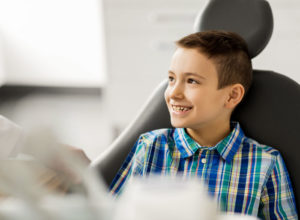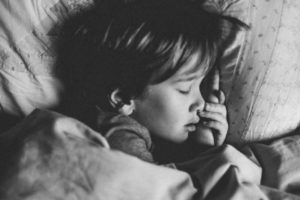Children With Sleep Apnea
Pediatric obstructive sleep apnea is a sleeping disorder of a child wherein their breathing will be somewhat or entirely blocked frequently while they sleep. It is a condition caused by blockage or narrowing of the child’s airway while they sleep. Adult sleep apnea is different.
Children, unfortunately, present the condition of obstructive sleep apnea (OSA) slightly differently than adults with OSA. While the condition normally impacts middle-aged men, for certain demographics, OSA can slip dangerously under the radar. Statistically, 3% to 12% of all children snore while they sleep, and around 1%-3% percent of all children have sleep apnea. Dentists have front row access to a child’s mouth development, and it’s no hyperbole to say that they could change the course of a child’s life and sleep patterns and give parents peace of mind with a proper diagnosis and sleep apnea treatment. No parent wants something as potentially threatening to their child’s health and development as sleep apnea to go unnoticed. And every parent wants their child to have a good night’s sleep.
Causes
While infected, enlarged tonsils and adenoids may be the most common cause of pediatric sleep apnea. Children sleep apnea can also be caused by allergies and certain developmental defects, such as low muscle tone in the mouth/upper airway, narrow airway, and underdeveloped maxillae are all known causes of obstructive sleep apnea.
Sleep Apnea Treatment Options
While surgically removing enlarged tonsils/adenoids are the most common treatment for sleep apnea in children, there are other options for managing OSA. (OSA – Obstructive Sleep Apnea) Depending on the cause and severity of the obstruction, pediatric surgery to correct any defects may be recommended. Oral/dental appliances and sleep apnea products may also be recommended for older children who are most done growing. Continuous positive airway pressure (CPAP) is also an effective sleep apnea option if all else fails.
- obstructive sleep apnea
- sleep apnea diagnosed
- sleep apnea treated
- a good night’s sleep, free of sleep apnea
Symptoms
While some of the symptoms of sleep apnea in children may take on the same basic form as adults (cessation of breathing during sleep), most symptoms differ, especially taking into consideration that while adults tend to gain weight due to hormone fluctuations caused by a lack of sleep, many children with sleep apnea demonstrate poor physical development and difficulty gaining weight. Parents should keep an eye out for the following symptoms that their child might exhibit:
- Breathing pauses during sleep
- Poor performance at school
- Daytime sleepiness
- Difficulty with concentration
- Mouth breathing
- Poor attention span
- Behavioral issues
- Bedwetting
- Difficulty growing and gaining weight
What Happens When a Child Has Sleep Apnea?
The symptoms of sleep apnea in children won’t only happen at night while your children sleep. If the children have a restless night and trouble with sleep due to this disorder, their symptoms during the daytime are falling asleep and fatigue and the child can have difficulty walking during the day. Young children and infants with this disorder may not snore while they sleep, specifically those with central sleep apnea. There are times that the only symptoms for the child are disturbed or troubled sleep.
How can I tell if my child has sleep apnea?
You should seek a pediatric doctor whenever you suspect that your child has sleep apnea. A pediatrician can always refer you to a child sleep specialist. The specialist will ask about their sleep and for your children’s apnea symptoms so they can correctly diagnose your child. They will also conduct a physical examination of your child and schedule you for a sleep study.
Sleep Study
For children to be assessed, they need to sleep overnight at the sleep clinic or hospital. For a sleep study to be conducted, a sleep technician then positions a test sensor on the kid’s body and monitors the following while they sleep:
- Oxygen level
- Breathing patterns
- Muscle activity
- Brain wave activity
- Heart rate

Electrocardiogram or ECG/EKG
If the specialist of your children is concerned that they may have heart disease, they can schedule your child for an electrocardiogram or ECG/EKG in addition to the sleep study they will conduct. It will record your child’s electrical activity in their heart and tell you more about their overall health, not just their sleep patterns.
Why it is important to test
Proper testing is vital for sleep apnea and is overlooked in children. It may happen even if the child doesn’t show any typical symptoms of sleep apnea disorder. For instance, rather than snoring and frequently napping during the day, a kid with sleep disorders could become restless, angry, and have mood changes, leading to a behavioral problem diagnosis. Seek pediatric medical advice from a health provider if your kid has close matches with sleep apnea symptoms and develops restlessness or other behavioral issues.
Can a Child Outgrow Central Sleep Apnea?
Although kids outgrow sleep apnea independently, this will not indicate that leaving the condition undiagnosed, untreated, and waiting for them to overcome it is wise or good for their sleep or health. Sleep apnea can take several years for children to outgrow.
Lack of sufficient rest or sleep throughout this period can increase a range of problems, such as poor academic performance, restlessness, and even wetting the bed. Sleep apnea therapy in children can considerably improve these signs and hugely positively affect a child’s happiness and health, putting them on the path to success and much better sleep.
Is Sleep Apnea Diagnosed Commonly in Kids?
Whether this is snoring, sleep apnea, or anything else, around 7 and 11 percent of youngsters have a nightly breathing condition while they sleep. 90% of them may be untreated or undiagnosed. Obstructive sleep apnea affects 1 to 5% of youngsters, per a 2014 study. It usually begins while they are between the ages of 2 and 8. In adults and children, obstructive sleep apnea is far more frequent than central sleep apnea.
Children’s Impacts of Untreated Sleep Apnea
Sleep apnea goes untreated for lengthy periods and leads to chronic daytime weariness. When untreated, sleep apnea can make it difficult for a youngster to concentrate in class. Developmental delays and low academic achievement may emerge as a result of this. Most kids also develop hyperactivity, leading to a misdiagnosis of attention deficit hyperactivity disorder or ADHD.
According to research, obstructive sleep-disordered breathing can create symptoms comparable to those seen in ADHD, and treating sleep apnea, if existent, can help alleviate these and other health problems. Severe sleep apnea that is untreated in kids might make it harder for them to thrive socially. Sleep apnea that is untreated causes development difficulties, cognitive delays, and heart difficulties in more extreme situations, as well as other health problems that obstructive sleep apnea can be a major part of.
These consequences are likely to improve if sleep apnea is adequately treated. In adults, sleep apnea may lead to excessive blood pressure, which increases the health risk of heart diseases and stroke. It could also be linked to childhood obesity. Treatment is important for your health when we are talking about a restricted airway that can deprive children of sleep due to OSA. ( Obstructive Sleep Apnea )
Children’s Sleep Apnea Therapy
There have been no standardized treatment protocols for kids with sleep apnea. A specialist may decide not to treat minor sleep apnea if there are no signs, at least not straight away.
Most children overcome sleep apnea, so the specialist may watch them see whether their condition improves. Doctors must evaluate the advantages of doing so against the dangers of untreated sleep apnea in the long run. Surgery and diet are the first therapies for kids with obstructive sleep apnea. Diet and therapy of underlying problems are the first therapy for children experiencing sleep apnea.
Surgery
Whenever swollen adenoids and tonsils trigger obstructive sleep apnea, your kid’s airway is typically opened by surgical removal of both the adenoids and tonsils. For a kid that satisfied the following conditions, adenoid extraction was found to be equally as beneficial as adenoids and tonsils removal in a medically reviewed 2016 report:
- was under the age of seven
- didn’t suffer obesity as a child
- had obstructive sleep apnea that was moderate rather than severe
- Tonsils were tiny
Kids With Sleep Apnea Outlook
Many youngsters benefit from sleep apnea therapy. The operation to remove the tonsils and adenoids lowers obstructive sleep apnea episodes in 27 to 79 percent of children, as per a 2018 review. Older kids who experienced childhood obesity or had more severe sleep apnea before treatment were more prone to developing problems after the operation.
Black children were also more likely than other children to develop symptoms after the operation, according to a 2013 random experiment. Nevertheless, they have more severe apnea. Weight loss, the use of a CPAP machine, or an oral appliance can help alleviate symptoms and clear their airway for better sleep and help with obstructive sleep apnea.

Visit our Pediatric Dentist page to read more helpful information.
